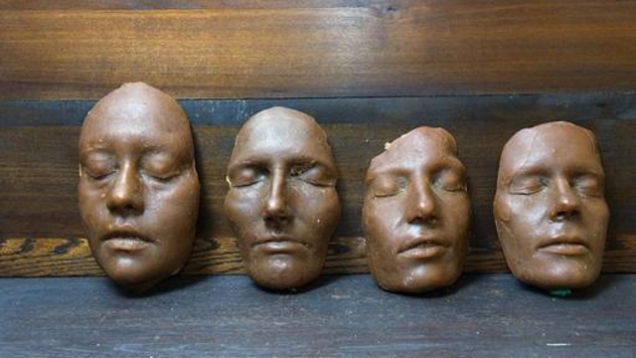A Time of Madness, Masks, and Clowns
On the 20th of August 2016, some clowns allegedly tried to lure a kid into the woods near his apartment complex in 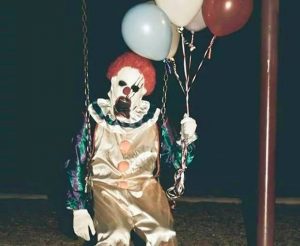 Greenville, South Carolina. Over the course of the next week, a further five sightings were reported to the local police department. Those of us who didn’t live in Greenville, especially those of us raised on Stephen King’s IT, were relieved to not be there. Over the course of the coming weeks, the number of sightings grew – as did the number of locations. People speculated that it was all some kind of publicity stunt for the upcoming IT remake, but the movie’s producer denied all. A kind of paranoia and hysteria grew around the clowns, and as the reports grew, so did the debate around just what the clowns were and why they had
Greenville, South Carolina. Over the course of the next week, a further five sightings were reported to the local police department. Those of us who didn’t live in Greenville, especially those of us raised on Stephen King’s IT, were relieved to not be there. Over the course of the coming weeks, the number of sightings grew – as did the number of locations. People speculated that it was all some kind of publicity stunt for the upcoming IT remake, but the movie’s producer denied all. A kind of paranoia and hysteria grew around the clowns, and as the reports grew, so did the debate around just what the clowns were and why they had 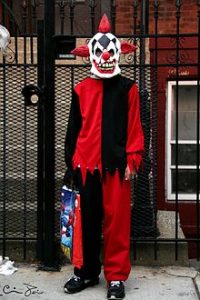 started to become so prominent. Some people pointed out the Fortean aspects of these crazes (which happen periodically), whereas others just stuck to more mundane explanations of creepy attention-seekers in bought or rented suits and masks. In a kind of collective madness, exacerbated by the fever of the late election cycle, we hurtled towards Halloween and rumors of a ‘clown purge’. With the exception of one Halloween night attack on a family by a gang of clowns that thankfully left them with comparatively minor injuries, there was no purge. Then as quickly as it began, it was all over and the clowns disappeared from the news.
started to become so prominent. Some people pointed out the Fortean aspects of these crazes (which happen periodically), whereas others just stuck to more mundane explanations of creepy attention-seekers in bought or rented suits and masks. In a kind of collective madness, exacerbated by the fever of the late election cycle, we hurtled towards Halloween and rumors of a ‘clown purge’. With the exception of one Halloween night attack on a family by a gang of clowns that thankfully left them with comparatively minor injuries, there was no purge. Then as quickly as it began, it was all over and the clowns disappeared from the news.
But regardless of whether some of the clowns were supernatural as some claimed, or simply fucked up people in scary masks, there is a curious history to clowns and the act of masking that deserves some examination. Because sometimes, as the saying goes, you have to dress for the job you want.
A Dichotomy of Clowns
Believe it or not, but as creepy as clowns are, the original clown (at least in the Anglosphere) was supposed to be a kind of harmless rustic fool. According to the Etymological Dictionary Online, the word ‘clown’ (as ‘cloyne’ or ‘clowne’) is theoretically derived from various Scandinavian language words for ‘clumsy’, and was first used in the 1560s to denote a ‘rustic boor, peasant’. (1) However, the word is not the thing, and the history of the ‘rustic fool’ figure in entertainment settings goes back to the Ancient Greek sklêro-paiktês, a word which comes from the verb paizein ‘to play like a child’. (2) This is not the only word for this kind of performer in Greek theater, but I do not need to include them here to further make the point that this figure of a ‘rustic fool’ that we call ‘clown’ is quite ancient.
Ancient Greek theater was inextricably tied up in acts of ritual, Aristotle even cited the cult of Dionysius as being the origins of drama.(3) While this is a claim that is still debated, it does illustrate that theater was not merely a form of entertainment for the Greeks (although it was undoubtedly that too).
The clowns, or rather ‘clown-like’ performers of today arguably have their origin in the Zanni of the 16th century Italian Commedia dell’Arte. There were essentially two types of Zanni: the stupid and boorish ( in other words, those we would recognize as being clowns today); and the intelligent trickster types. Strangely, it is the more threatening Zanni, the member of the Zanni known as Arlecchino – despite his somewhat darker theorized origins – who is considered to be among the stupid. To quote Jennifer Meagher from the Metropolitan Museum of Art:
” The zanni (servants) were in many ways the most important—and certainly the most subversive—characters of 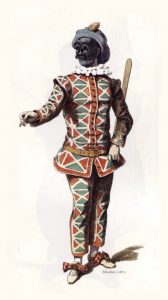 the commedia, as their antics and intrigues decided the fate of frustrated lovers, disagreeable vecchi, and each other. Perhaps best known of these is Arlecchino, or Harlequin (1974.356.525), a character whose origin is contested. It is likely that he derived either from Alichino, a demon from Dante’s Inferno (XXI-XXIII), or from Hellequin, a character from French Passion plays, also a demon charged with driving damned souls into Hell. Arlecchino is characterized as a poor man, often from Bergamo, whose diamond-patterned costume suggests that he is wearing patchwork, a sign of his poverty. His mask is either speckled with warts or shaped like the face of a monkey, cat, or pig, and he often carries a batacchio, or slapstick.”(4) (Emphasis is my own.)
the commedia, as their antics and intrigues decided the fate of frustrated lovers, disagreeable vecchi, and each other. Perhaps best known of these is Arlecchino, or Harlequin (1974.356.525), a character whose origin is contested. It is likely that he derived either from Alichino, a demon from Dante’s Inferno (XXI-XXIII), or from Hellequin, a character from French Passion plays, also a demon charged with driving damned souls into Hell. Arlecchino is characterized as a poor man, often from Bergamo, whose diamond-patterned costume suggests that he is wearing patchwork, a sign of his poverty. His mask is either speckled with warts or shaped like the face of a monkey, cat, or pig, and he often carries a batacchio, or slapstick.”(4) (Emphasis is my own.)
Also worthy of note here, is the fact that “All characters except Pedrolino and the innamorati wore masks, a tradition deriving from ancient Roman comedies, Atellanae Fabulae, that featured character types similar to those of the commedia.” (5) The Commedia has its roots in old old custom.
To return to that first quote though, and Arlecchino’s connection with hell in both of his origins stories, there is a far richer history to be found here that makes this hellish connection, and especially with the dead especially apt.
Harlequin and Herela Cyng
Harlequins are curious things, both in terms of their dress as the black-masked performer in checkered material carrying a club, and the history suggested by the etymology of their name. The most complete exposition of the history of both the name and character comes from Flasdieck in his 1937 article entitled “Harlekin. Germanischer Mythos in romanischer Wandlung”. In it, the origins of the word ‘Harlequin’ are traced back to the OE *Her(e)la cyng, or ‘King Harilo’, which is itself a by-name of Wodan – a god connected with leading the dead in the form of the Wild Hunt. (6) In turn, Flasdieck traces ‘Her(e)la’ back to *Xarilan – a word deriving from *Xaria, or ‘army’. This is synonymous with Herjann, and leads us to the Germanic tribal name, the Harii. (It’s all a lot more complex than that, I’m trying to condense about seven pages of etymology into less than a paragraph. Seriously, get Kershaw’s book if you can.)
Remember the black mask of the Harlequin? Maybe it’s no coincidence – per Tacitus in Germania 43 (emphasis is my own):
“As for the Harii, quite apart from their strength, which exceeds that of the other tribes I have just listed, they pander to their innate savagery by skill and timing: with black shields and painted bodies, they choose dark nights to fight, and by means of terror and shadow of a ghostly army they cause panic, since no enemy can bear a sight so unexpected and hellish; in every battle the eyes are the first to be conquered.”
Masks and Ritual

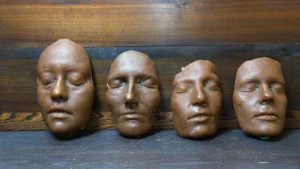
Returning to the ancient classical world though, and this time the funerals of Rome, we see the act of masking in impersonation of the dead. One of the living would wear a death mask and clothes of the newly deceased, and impersonate them as much as they could. To clarify a little here, by ‘death mask’, I mean masks molded from the actual face of the deceased usually after death. Other mourners would similarly impersonate the ancestors of the deceased with their own respective masks. (7) Viewed from this perspective, the funeral then becomes a drama in which the decedent is escorted to the grave by the dead themselves.
To quote Kershaw in her ‘The One Eyed God: Odin and the (Indo) Germanic Männerbünde’, “It is the nature of the dead that they are not seen”, and yet there were times during the ritual year when the dead very much needed to be present. So how to solve a problem like that? How to give form to the unseen?(8)
Again from Kershaw (emphasis is my own): “The means by which they become the dead are Masks. By mask we do not necessarily mean something which covers the face. The most primitive form of masking is simply painting the face (and body). And while we have, from Scandinavia, representations of cultic dancers wearing very realistic wolfs’ heads and fur garments reaching to the knees, as in the helmet plate from Torslunda described in 1.4.3 above, other masks consist of (or are made to look like ?) parts of an animal’s head, or the whole head with the jaws agape and the masker’s face showing, as in the pictures of Herakles in his lion skin or Hades in his ????….The mask shows that the wearer is a dæmonic, or more-than-natural, being. He is no longer himself: he is an Ancestor.” (9)
Though Kershaw was writing about the embodiment of ancestors by living warriors by means of donning masks, this same principle applies equally to the impersonation of the deceased at the Roman funeral – the belief in possession by ghosts or the ‘more-than-natural’ is quite ancient.
Exapanding the ‘More-Than-Natural’
Earlier on in this post, I made the joke that sometimes you have to dress for the job you want, hopefully that joke is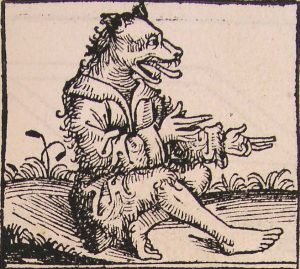 becoming somewhat clearer now. But I do not believe that this principle applies solely to the dead, and that we can see a form of this kind of embodiment of the ‘more-than-natural’ in some of the sources on shapeshifting too. For example, Sigmund and Sinfjötli of the Volsunga Saga become wolves through the donning of skins, and this theme survived into the 17th century when Thiess the self-described werewolf of Livonia testified that he and his fellow werewolves [on their journey to hell to retrieve seeds stolen by a sorcerer called Skeistan] had to strip off and don skins. (10)
becoming somewhat clearer now. But I do not believe that this principle applies solely to the dead, and that we can see a form of this kind of embodiment of the ‘more-than-natural’ in some of the sources on shapeshifting too. For example, Sigmund and Sinfjötli of the Volsunga Saga become wolves through the donning of skins, and this theme survived into the 17th century when Thiess the self-described werewolf of Livonia testified that he and his fellow werewolves [on their journey to hell to retrieve seeds stolen by a sorcerer called Skeistan] had to strip off and don skins. (10)
Conversely, a person might return to the human state by either shucking the mask or skin, and/or dressing once more in the clothes of man. We see this at play in Petronius’s Satyricon in which a soldier protects his clothes by magically turning them into stone before turning into a werewolf. To protect one’s clothes is to protect one’s ability to return to the human state. This theme is also present in Marie de France’s 12th century lay Bisclavret (a Breton word meaning ‘werewolf’) in which a werewolf’s clothes are stolen him from returning to his human form.(11) This is not so different from the protective powers of cultivated land when being pursued by the Other in the wilds, the clothes acting as a civilizing influence in much the same way as working the land does a field.
Of Masks and Clowns
The 2016 spate of clown sightings were noteworthy in numerous ways, not in the least because every single clown described was of the ‘horror’ variety. They were embodying the Pennywise, the sick, murderous clown that goes out of its way to terrify children and adults alike, and all during a time of high passion and acrimonious national discourse. Given the historical use of masking within ritual contexts, and the meaning of that act of masking, a whole new dimension is added to the question of just what possessed those people to don those masks and go out behaving in ways they perhaps wouldn’t normally. Now obviously, I’m not suggesting that all of those clowns were possessed by some spirits stirred up by the then-zeitgeist, but it is an interesting thought, isn’t it?
Sources
(1) Etymological Dictionary Online – Clown
http://www.etymonline.com/index.php?term=clown
(2) Etymological Dictionary Online – Coulrophobia
http://www.etymonline.com/index.php?term=coulrophobia
(3) The Origins of Theater in Ancient Greece and Beyond: From Ritual to Drama – Eric Csapo, Margaret C. Miller P
(4)+(5) Commedia dell’Arte – Jennifer Meagher
http://www.metmuseum.org/toah/hd/comm/hd_comm.htm
(6) The One Eyed God: Odin and the (Indo) Germanic Männerbünde – Kris Kershaw (Pp 11, 15-19, 38-40)
(7) Impersonating the Dead: Mimes at Roman Funerals – Geoffrey S. Sumi
(8) The One Eyed God: Odin and the (Indo) Germanic Männerbünde – Kris Kershaw (p26)
(9) Ibid.
(10) Witches, Werewolves, and Fairies: Shapeshifters and Astral Doubles in the Middle Ages – Claude LeCouteux (Pp 118-121)
(11) Witches, Werewolves, and Fairies: Shapeshifters and Astral Doubles in the Middle Ages – Claude LeCouteux (Pp113-116)

